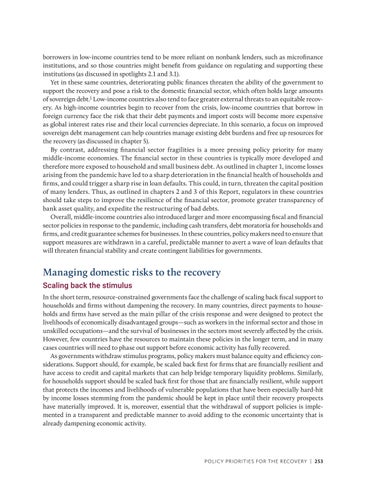borrowers in low-income countries tend to be more reliant on nonbank lenders, such as microfinance institutions, and so those countries might benefit from guidance on regulating and supporting these institutions (as discussed in spotlights 2.1 and 3.1). Yet in these same countries, deteriorating public finances threaten the ability of the government to support the recovery and pose a risk to the domestic financial sector, which often holds large amounts of sovereign debt.1 Low-income countries also tend to face greater external threats to an equitable recovery. As high-income countries begin to recover from the crisis, low-income countries that borrow in foreign currency face the risk that their debt payments and import costs will become more expensive as global interest rates rise and their local currencies depreciate. In this scenario, a focus on improved sovereign debt management can help countries manage existing debt burdens and free up resources for the recovery (as discussed in chapter 5). By contrast, addressing financial sector fragilities is a more pressing policy priority for many middle-income economies. The financial sector in these countries is typically more developed and therefore more exposed to household and small business debt. As outlined in chapter 1, income losses arising from the pandemic have led to a sharp deterioration in the financial health of households and firms, and could trigger a sharp rise in loan defaults. This could, in turn, threaten the capital position of many lenders. Thus, as outlined in chapters 2 and 3 of this Report, regulators in these countries should take steps to improve the resilience of the financial sector, promote greater transparency of bank asset quality, and expedite the restructuring of bad debts. Overall, middle-income countries also introduced larger and more encompassing fiscal and financial sector policies in response to the pandemic, including cash transfers, debt moratoria for households and firms, and credit guarantee schemes for businesses. In these countries, policy makers need to ensure that support measures are withdrawn in a careful, predictable manner to avert a wave of loan defaults that will threaten financial stability and create contingent liabilities for governments.
Managing domestic risks to the recovery Scaling back the stimulus In the short term, resource-constrained governments face the challenge of scaling back fiscal support to households and firms without dampening the recovery. In many countries, direct payments to households and firms have served as the main pillar of the crisis response and were designed to protect the livelihoods of economically disadvantaged groups—such as workers in the informal sector and those in unskilled occupations—and the survival of businesses in the sectors most severely affected by the crisis. However, few countries have the resources to maintain these policies in the longer term, and in many cases countries will need to phase out support before economic activity has fully recovered. As governments withdraw stimulus programs, policy makers must balance equity and efficiency considerations. Support should, for example, be scaled back first for firms that are financially resilient and have access to credit and capital markets that can help bridge temporary liquidity problems. Similarly, for households support should be scaled back first for those that are financially resilient, while support that protects the incomes and livelihoods of vulnerable populations that have been especially hard-hit by income losses stemming from the pandemic should be kept in place until their recovery prospects have materially improved. It is, moreover, essential that the withdrawal of support policies is implemented in a transparent and predictable manner to avoid adding to the economic uncertainty that is already dampening economic activity.
POLICY PRIORITIES FOR THE RECOVERY | 253

